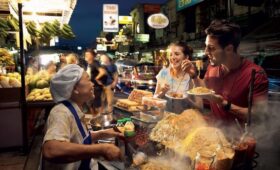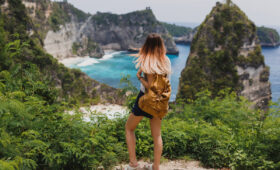Are you looking for the most famous Buddhist temples in Thailand? Among the many fascinating tourist spots in this area, this page provides the most extensive catalog of temples. The variety of activities in Thailand makes it a great vacation spot. Beautiful views and mouthwatering cuisine are the two most common associations that tourists have with this nation.
Travelers visiting Thailand may take in the sights and sounds of the local culture, eat delectable local specialties, and shop at crowded marketplaces. Moreover, you can marvel at skyscrapers, stay in posh resort cities, relax on tropical beaches, or explore the country’s rugged interior. But there is one experience that is quickly becoming popular all over the world: visiting Thailand’s holy temples. These places have drawn many tourists looking for peace of mind. Contact us for more details!
Explore Thailand tours from Sri Lanka to experience this captivating destination firsthand.
Buddhism in Thailand
The vast majority of Thais (almost all of them) adhere to Buddhism. This faith, deeply ingrained in Thai society, permeates many aspects of daily life in Thailand. There are several Buddhist temples, or “Wat,” across the nation, and many people see them as places of worship and fellowship. Thai culture holds Buddhist monks in the highest esteem because of their austere lifestyle of meditation and prayer. Buddhist ceremonies, particularly those commemorating the beginning and end of a life cycle (e.g., marriages and funerals), are also very significant in Thai culture.
Even those who do not actively follow the faith in Thailand often engage in religious rituals like meditation and providing food to monks. Thailand celebrates the Buddhist New Year (Songkran) and the floating lantern festival (Loy Krathong) all year round. Now let’s get the list of the most famous Buddhist temples in Thailand.
Famous Buddhist Temples in Thailand
Wat Phra Si Sanphet, Ayutthaya

This is without a doubt one of the most famous Buddhist temples in Thailand that you shouldn’t miss. As the former capital of Thailand until its destruction by the Burmese army in the 18th century, Ayutthaya is as important to Thai Buddhists as Bangkok. Buddhists still hold these locations in high regard. Therefore, a spiritual visit is worthwhile, even if the Burmese army destroyed many of the structures and stole the most priceless sculptures.
The Royal Palace is now part of Wat Phra Si Sanphet, which is the city’s biggest temple and home to a group of stupas.
Famous Buddhist temples in Thailand: Wat Phra Kaew, Bangkok

Originally constructed by Buddha Yodfa Chulaloke on the premises of the Grand Palace, Wat Phra Kaew is perhaps the most important Buddhist shrine in Thailand. Notable for housing the Emerald Buddha, this magnificent complex has over 100 separate structures and towers.
All visitors to Thailand should make time to view this famous statue. This sacred statue stands at a little over half a meter tall and is considered a sacred Buddhist relic.
Sanctuary of Truth

An architectural marvel, Pattaya’s Sanctuary of Truth is Thailand’s biggest wood structure. It is also one of the most famous Buddhist temples in Thailand. 1981 marked the beginning of development, and the conclusion of the project is anticipated to take place in 2025. The construction of the temple is now ongoing, using traditional building techniques and hand-hewn woodworking skills. Its basis is the notion of impermanence.
Around the temple’s four sides are elaborate wood carvings that symbolize life’s philosophy. Religious symbols from Thailand, Cambodia, China, and India adorn each wing.
Wat Suthat

The Thailand Temple of the Great Swing is well-known for its enormous swing. The Rattanakosin period saw the construction of many significant temples in Bangkok, the earliest of which was Wat Suthat. It is among the six most important royal temples in Thailand and is in the top class.
To contain a bronze Buddha sculpture from Sukhothai dating back to the 13th century, King Rama I (1782–1809) had Wat Suthat constructed. Rama III (1824–1851), king of Thailand, finished building the temple. Wall paintings in the main hall of worship show scenes from the Buddha’s twenty-four prior incarnations. Around the outside of the temple are hexagonal pagodas with eight stories and Chinese stone sculptures.
Wat Rong Khun

The White Temple, or Wat Rong Khun, sits in northern Thailand. In the environment of religious structures, its sculptures and frescoes stand out, in addition to their hues. This temple is very different from the others in Thailand. It is very white, which represents the purity of Buddhism. It is also adorned with fragments of mirrors, symbolizing the image of awareness.
You have to go across a pool full of underworld monsters and then squeeze between two enormous teeth to get there.
Wat Phra That Lampang Luang, Lampang

This is another one of the most famous Buddhist temples in Thailand that tourists love to explore. An architectural treasure of the northern Thai province of Lampang is the 15th-century Wat Phra That Lampang Luang. It is one of the country’s most beautiful temples and a popular tourist attraction. This famous temple seems like a castle because of an eighth-century defensive wall that encircles it on all sides. The temple is situated on a small hill.
Meaning “Relic of the Great Buddha of the Temple of Lampang,” the name “Wat Phra That Lampang Luang” translates to something like this. According to a story, the Buddha went to the site about 2500 years ago and gave one of his hairs and straight bones from his face and neck. The temple now houses these in its large chedi.
Wat Pa Maha Chedi Kaew

According to many tourists and history lovers, this is among the most famous Buddhist temples in Thailand. Wat Pa Maha Chedi Kaew stores about 1.5 million Heineken and Chang (a famous Thai beer) bottles. Wat Pa Maha Chedi Kaew is also known as the Temple of a Million Bottles. The project began in 1984 when the temple’s founder, Phra Khru Vivek Dharmajahn, found a nearby dump full of thrown-away bottles. Since then, the monks have kept adding to the temple complex, building a chapel, water towers, a crematorium, housing for the monks, and an entrance gate made of green and brown glass bottles.
Wat Chantaram

The common name “The Glass Temple” for Wat Chantaram (or Wat Tha Sung) is logical given its spectacular appearance. Located in west-central Thailand, the inside of the holy area resembles a fun house with a house of mirrors.
Many glass columns that reflect light cover the walls. These columns lead up to a huge golden Buddha statue that looks just like the original Phra Phuttha Chinnarat statue. Wat Phra Si Rattana Mahathat is home to this statue, often referred to as “the most beautiful image of Buddha in Thailand.”
Famous Buddhist temples in Thailand: Phra Maha Chedi Chai Mongkol

Many people call it “The Great, Victorious, and Auspicious Pagod.” It is also one of the biggest chedis (pagodas) in Thailand. It sits atop the Roi Et provincial temple complex in rural northeastern Thailand, at Wat Pha Namthip Thep Prasit Vararam.
On a piece of land that is 101 Rai, or about 40 acres, this huge chedi was built. It is 101 meters long, 101 meters wide, and 101 meters high. The province named Roi Et, which translates to 101 in Thai, is home to the number 101.
Phra Mahathat Kaen Nakhon

“The nine-story chedi,” or Phra Mahathat Kaen Nakhon, is the most impressive and noticeable landmark in Khon Kaen. The chedi is in Wang Nong Waeng, a royal temple beside Kaen Nakhon Lake in Khon Kaen town. The temple of Wat Nong Waeng has been around since 1793.
Several heads of the Buddhist mythical serpent Nagas stretch out on the steps leading up to the temple. A Dhamma wheel with two elephants, Naga serpents, and pictures of Buddha are among the symbols and imagery found on the expansive 4½ acre temple grounds that surround the chedi.
Photo credits go to the respective owners.




